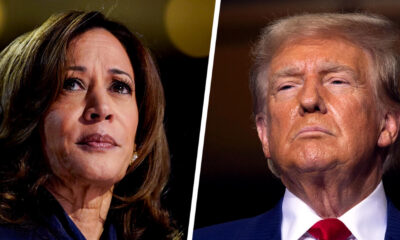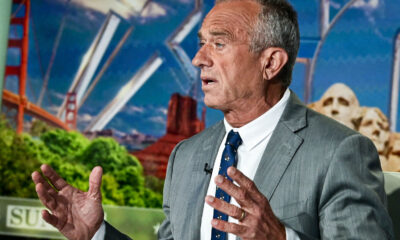The Dictatorship
Israel targets Iran’s government and a key Tehran prison as Iran launches more attacks on Israel

DUBAI, United Arab Emirates (AP) — U.S. President Donald Trump announced that Israel and Iran had agreed to a “complete and total ceasefire” soon after Iran launched a limited missile attack Monday on a U.S. military base In Qatarretaliating for the American bombing of its nuclear sites. But the status of a possible ceasefire remained tentative after an Iranian missile barrage struck Israel after a first deadline for the proposal.
The Iranian barrages sent Israelis hurrying into bomb shelters as the sun rose, killing at least four people and injuring eight others, Israel’s Magen David Adom rescue services said. Israel has yet to acknowledge Trump’s proposal, which gives Israel more time to potentially strike back though Iran on its state television announced an overall ceasefire had begun at 7:30 a.m. local time.
In Beersheba, first responders said they retrieved four bodies from one building and were searching for more. The streets around the impact site were littered with glass and debris, windows were blown out of buildings as anxious neighbors stood outside their damaged houses. Three people were rescued from nearby buildings.
The direct hit in the largest city in southern Israel came just days after the city’s hospital sustained significant damage in a missile strike.
The Israeli military said people could leave bomb shelters but cautioned the public to stay close to shelter for the coming hours.
Trump’s announcement that Israel and Iran had agreed to a “complete and total ceasefire” came soon after Iran launched a limited missile attack Monday on a U.S. military base In Qatarretaliating for the American bombing of its nuclear sites. Israel has not acknowledged the Trump ceasefire announcement.
Trump’s announcement on Truth Social said the ceasefire beginning about midnight Washington time would bring an “Official END” to the war.
Writing over an hour after the first phase of the tentative ceasefire, which called for Iran to halt its attacks, Trump added: “THE CEASEFIRE IS NOW IN EFFECT. PLEASE DO NOT VIOLATE IT! DONALD J. TRUMP, PRESIDENT OF THE UNITED STATES!”
Israel doesn’t confirm ceasefire but appears to pause strikes
Israel did not immediately acknowledge any ceasefire, but there were no reports of Israeli strikes in Iran after 4 a.m. in Tehran. Heavy Israeli strikes continued in Iranian cities until shortly before that time. Israel in other conflicts has stepped up its strikes just before ceasefires took effect.
“As of now, there is NO ‘agreement’ on any ceasefire or cessation of military operations,” Iranian Foreign Minister Abbas Araghchi wrote in a post on X. “However, provided that the Israeli regime stops its illegal aggression against the Iranian people no later than 4 am Tehran time, we have no intention to continue our response afterwards.”
His message was posted at 4:16 a.m. Tehran time. Araghchi added: “The final decision on the cessation of our military operations will be made later.”
The Israeli military declined to comment on Trump’s ceasefire statement and the office of Israeli Prime Minister Benjamin Netanyahu did not immediately respond to a message seeking comment.
Trump describes conflict as ’12 Day War’
Trump gave the conflict between Israel and Iran a name: the “12 Day War.” That recalls the 1967 Mideast war, known by some as the “Six Day War,” in which Israel fought a group of Arab countries including Egypt, Jordan and Syria.
Trump’s reference carries emotional weight for the Arab world, particularly Palestinians. In the 1967 war, Israel captured the West Bank and east Jerusalem from Jordan, the Gaza Strip and the Sinai Peninsula from Egypt, and the Golan Heights from Syria. Though Israel later gave the Sinai back to Egypt, it still holds the other territories.
Trump communicated directly with Israeli Prime Minister Benjamin Netanyahu to secure the ceasefire, according to a senior White House official who insisted on anonymity to discuss the Monday talks. Vance, Secretary of State Marco Rubio and special envoy Steve Witkoff communicated with the Iranians through direct and indirect channels.
The White House has maintained that the Saturday bombing helped get the Israelis to agree to the ceasefire and that the Qatari government helped to broker the deal.
It’s unclear what role Ayatollah Ali Khamenei, Iran’s leader, played in the talks. He said earlier on social media that he would not surrender.
Iran’s attack against US implied willingness to de-escalate
Iran attacked a U.S. base in Qatar on Monday, but appeared to indicate it was prepared to reduce tensions. The U.S. was warned by Iran in advance, and there were no casualties, said Trump, who dismissed the attack as a “very weak response.”
Qatar condemned the attack on Al idid on base as “a flagrant violation” of its sovereignty, airspace and international law. Qatar said it intercepted all but one missile, though it was not clear if that missile caused any damage.
Iran said the volley matched the number of bombs dropped by the United States on Iranian nuclear sites over the weekend. Iran also said it targeted the base because it was outside of populated areas.
Qatar Maj. Gen. Shayeq Al Hajri said 19 missiles were fired at the base that is home to the Combined Air Operations Center, which provides command and control of air power across the region, as well as the 379th Air Expeditionary Wing, the largest such wing in the world. Trump said 14 missiles were fired, 13 were knocked down and one was “set free” because it posed no threat.
This satellite picture by Planet Labs PBC shows Iran’s underground nuclear enrichment site at Fordo following U.S. airstrikes targeting the facility, on Sunday, June 22, 2025. (Planet Labs PBC via AP)
This satellite picture by Planet Labs PBC shows Iran’s underground nuclear enrichment site at Fordo following U.S. airstrikes targeting the facility, on Sunday, June 22, 2025. (Planet Labs PBC via AP)
People enter a synagogue’s bomb shelter as air raid sirens warn of incoming Iranian strikes in Haifa, Israel, Monday, June 23, 2025. (AP Photo/Baz Ratner)
People enter a synagogue’s bomb shelter as air raid sirens warn of incoming Iranian strikes in Haifa, Israel, Monday, June 23, 2025. (AP Photo/Baz Ratner)
Iran announced the attack on state television, with a caption calling it “a mighty and successful response” to “America’s aggression.”
Earlier reports that a missile was launched at a base housing American forces in Iraq were a false alarm, a senior U.S. military official said. The official, who spoke on condition of anonymity because he was not authorized to comment publicly, said debris from a malfunctioning Iranian missile targeting Israel had triggered an alert of an impending attack on the Ain al-Assad base.
By early Tuesday, Qatar Airways resumed its flights after Qatar shut down its airspace over the Iranian attack on Al Udeid Air Base. Flight-tracking data showed commercial aircraft again flying in Qatari airspace, signaling Doha believed the threat on the energy-rich nation had passed.
The Israel Airport Authority said that the barrages from Iran forced them to close the country’s skies for sevearl hours to all passenger planes that were expected to land and depart, including emergency flights.
Some flights were forced to circle over the Mediterranean Sea, according to Israeli media.
Israel’s airports have been closed since the war with Iran began, but a handful of emergency flights had started arriving and departing over the past few days.
Israel and Iran trade attacks
Israel and Iran traded barrages early Tuesday morning.
Iran struck Israel with missiles and drones while Israel said it attacked “regime targets and government repression bodies in the heart of Tehran.”
In Tehran, Israel hit the headquarters of the military force that suppressed recent protests and blew open a gate at Evin prison, which is known for holding political activists.
Iranian state television aired footage it said was shot inside Evin, with prisoners under control. However, the Washington-based Abdorrahman Boroumand Center for Human Rights in Iran said many families of detainees “have expressed deep concern about the safety and condition of their loved ones” in the prison.
The Israeli military also confirmed it struck roads around Iran’s Fordo enrichment facility to obstruct access to the site. The underground site was one of those hit in Sunday’s attack by the United States. The Israeli military did not elaborate.
In Vienna, the head of the United Nations nuclear watchdog said he expected there to be heavy damage at the Fordo facility following Sunday’s U.S. airstrike there with sophisticated bunker-buster bombs.
Several Iranian officials, including Atomic Energy Organization of Iran spokesman Behrouz Kamalvandi, have claimed Iran removed nuclear material from targeted sites ahead of time.
Trump floats regime change
Israeli officials insisted they did not seek the overthrow of Iran’s government, their archenemy since the country’s 1979 Islamic Revolution.
But the latest strikes unfolded only hours after Trump himself mentioned the possibility of regime change a day after inserting America into the war with its stealth-bomber strike on three Iranian nuclear sites.
“If the current Iranian Regime is unable to MAKE IRAN GREAT AGAIN, why wouldn’t there be a Regime change???” he asked on his Truth Social website. White House press secretary Karoline Leavitt later described Trump as “simply raising a question.”
Before the news of a ceasefire, an Israeli official, speaking on condition of anonymity to discuss high-level internal deliberations, said Israel aimed to wind down the war in the coming days, but that it would depend on the Iranians.
AP AUDIO: Israel expands war against Iran to target symbols of its power, including a notorious prison
AP correspondent Joe Federman reports Israeli Prime Minister Benjamin Netanyahu welcomes U.S. support in the Israel-Iran war.
A motorbike drives in a quiet square in downtown Tehran, Iran, Monday, June 23, 2025. (AP Photo/Vahid Salemi)
A motorbike drives in a quiet square in downtown Tehran, Iran, Monday, June 23, 2025. (AP Photo/Vahid Salemi)
Israel’s preferred outcome is for Iran to agree to a ceasefire and reenter negotiations with the U.S. over its nuclear program, the official said. But Israel is prepared for the possibility of an extended low-intensity war of attrition or period of “quiet for quiet,” in which it would closely monitor Iran’s activities and strike if it identifies new threats.
Conflict has killed hundreds
In Israel, at least 24 people have been killed and more than 1,000 wounded in the war. Israeli strikes on Iran have killed at least 974 people and wounded 3,458 others, according to the Washington-based group Human Rights Activists.
The group, which has provided detailed casualty figures from Iranian unrest such as the protests surrounding the death of Mahsa Amini in 2022, said of those killed, it identified 387 civilians and 268 security force personnel.
The U.S. has evacuated some 250 American citizens and their immediate family members from Israel by government, military and charter flights that began over the weekend, a State Department official said.
There are roughly 700,000 American citizens, most of them dual U.S.-Israeli citizens, believed to be in Israel.
___
In this photo released on Monday, June 23, 2025, by Iranian army press service, Iran’s army commander-in-chief Gen. Amir Hatami, center, Admiral Mahmoud Mousavi, right, and Admiral Habibollah Sayyari attend a meeting in Zolfaghar central headquarters, Iran. (Iranian Army Press Service via AP)
In this photo released on Monday, June 23, 2025, by Iranian army press service, Iran’s army commander-in-chief Gen. Amir Hatami, center, Admiral Mahmoud Mousavi, right, and Admiral Habibollah Sayyari attend a meeting in Zolfaghar central headquarters, Iran. (Iranian Army Press Service via AP)
Lidman reported from Tel Aviv, Israel. Associated Press writers Josef Federman in Jerusalem, Qassim Abdul-Zahra in Baghdad, Abby Sewell in Beirut, Elise Morton in London, Geir Moulson in Berlin, Ella Joyner in Brussels, Edith M. Lederer at the United Nations and Stephanie Liechtenstein in Vienna contributed to this report.
The Dictatorship
In major blow to GOP, over $500 billion of megabill’s budget cuts deemed against the rules

In the past week, Senate parliamentarian Elizabeth MacDonough has ruled that several portions of the GOP megabillthe signature legislation of President Trump’s first year back in office, violated the chamber’s rules for the budget reconciliation process, and cannot be passed on party lines. Thursday morning, MacDonough issued a slew of new rulings — and dealt a major blow to Republican plans to rush the bill to Trump’s desk.
To avoid a Senate filibuster, Republicans are moving the bill through the chamber using the budget reconciliation process, which allows bills to be passed with a simple majority. But the Senate has strict requirements for what can be passed under budget reconciliation, and on Thursday MacDonough disqualified more than a dozen of the bill’s provisions under those rulesincluding several restrictions on Medicaid, student aid and other assistance for certain non-citizen immigrants, as well as a prohibition on Medicaid and Children’s Health Insurance Program funding for gender-affirming care. Each provision, if Republicans left them in, would be subject to a 60-vote threshold — which means Democrats could block them. UPDATE (June 27, 2025, 9:25 a.m. ET): On Friday, MacDonough ruled against several more provisionsincluding increased penalties for disclosure of taxpayer information (which the GOP had pushed after leaks of Trump’s tax returns) and deregulation of gun silencers.
Senate Republicans will try to save what provisions they can by rewriting the bill’s language.
MacDonough’s most significant ruling, though, concerned the bill’s limits on the Medicaid provider tax, which helps states obtain more federal matching funds for the program. That change already faced opposition from several GOP senators, including Josh Hawley and Susan Collinswho particularly fear its impact on rural hospitals. But Republican leaders have pushed to keep it in because it would save approximately $250 billion, a desperately needed offset to the Senate bill’s additional tax cuts. In total, the parliamentarian’s decisions threaten well over $500 billion of the bill’s cutsaccording to a rough analysis from Bobby Kogan, a federal budget expert at the Center for American Progress.
Some Republican lawmakers criticized MacDonough after her rulings. On X, Sen. Tommy Tuberville, R-Ala. called for “the WOKE Senate Parliamentarian” to be fired. Rep. Greg Steube, R-Fla., demanded Vice President JD Vance “overrule the Parliamentarian” — which Vance does not have the power to do.
In fact, while it’s true that the parliamentarian is unelected, the very-much-elected senators could overrule her at any time if they wish. But as Senate Majority Leader John Thune told Punchbowl News in January“That’s totally akin to killing the filibuster. We can’t go there.” There are good arguments for getting rid of the filibuster, and Democrats even tried to change the filibuster rules in 2022 to pass a voting rights bill, only for then-Democratic Sens. Kyrsten Sinema and Joe Manchin to join Republicans against the effort. But there’s little support for that path in the Senate GOP. “That would not be a good option for getting a bill done,” Thune reiterated to Politico Thursday.
Instead, Senate Republicans will try to save what provisions they can by rewriting the bill’s language. “But it’s not really clear how many of [the provisions] they can cure,” NBC News’ Sahil Kapur told MSNBC’s Ana Cabrera. Not that Trump will be interested in those details: Republican Sen. Josh Hawley told the New York Times earlier this month that Trump wasn’t even aware of the bill’s changes to the provider tax.
What Trump will care about, though, is how it affects the bill’s timeline. “The Republican sources I’ve talked to say this is not fatal to the bill,” Kapur reported, but “the bill clearly isn’t ready for prime time as is.” The Senate had hoped to begin voting on the legislation Friday, with the goal of getting the final version to the president by July 4. The necessary rewrites — and especially the lack of clarity about the changes to the provider tax — will at least scramble that timeline, if not delay it.
Republicans in Congress want this legislation off their plates.
Republicans likely could have avoided this slapdash process had they moved the bill along more slowly. “A slow process benefits the majority,” observed Koganas it gives them more time to ensure the bill’s language doesn’t fall afoul of Senate rules or contain other errors. And surely a bill that takes away health care from millions of Americans, mostly to finance tax cuts for the wealthiest, deserves a considered, thoughtful hearing?
But Republicans in Congress want this legislation off their plates: the bill is already unpopular and only gets less popular when you ask voters about specifics. And the president, with his approval ratings deeply underwater and creeping still further down, wants a bill he can sign and show to the cameras. The details — and the consequences — are someone else’s problem.
James Downie is a writer and editor for BLN Daily. He was an editor and columnist for The Washington Post and has also written for The New Republic and Foreign Policy.
The Dictatorship
Major corporations are showing their true colors this Pride — but we’re still here

This article is part of “Finding Pride in a Divided America,” a special series from BLN Daily.
The last time I attended a Pride parade, it was 2019 in Washington, D.C. I had been to a few before — Portland, Mainewhich I had just moved away from, and of course Boston, which is something of a rite of passage for New England queers like me.
Each one felt like a corporate and political spectacle. I met Sen. Elizabeth Warren at the Boston parade in 2017, not long before she unsuccessfully ran for president. My daughter and I marched with a group of colleagues from a former employer of mine, a local Maine bank, that same year, tossing rainbow-themed tchotchkes to the cheering crowds lining Congress Street in Portland’s downtown.
It’s hard to feel proud of yourself when the parade that’s supposed to honor your identity is sponsored by Raytheon.
I didn’t go to Pride in 2020 in part thanks to Covid — but also because I was getting tired of the “corporateness” of it all. It’s hard to feel proud of yourself when the parade that’s supposed to honor your identity is sponsored by Raytheon. That dissonance is partly what led me to stop attending those events.
But looking back now, those years feel like a quaint bygone era in queer rights. With Donald Trump sweeping into office on the back of hundreds of millions of dollars spent on anti-trans ads as he led a crusade against DEI effortscorporate America responded in kind. And among the first items on the chopping block were Pride sponsorships and corporate support for LGBTQ rights.
This year, Pride has been marked by major corporations, some of which had been our community’s first corporate allies, backing out of major sponsorships. Anheuser-Busch, the parent company of Budweiser, ended its 30-year run as lead sponsor of St. Louis’ PrideFest and pulled back on its spending on San Francisco’s Pride events. Comcast, BLN’s parent company, pulled its sponsorship from San Francisco Pride.
Mastercard, PepsiCo and Citibank ended relationships with New York City Pride, while Booz Allen Hamilton, Deloitte and Visa pulled out of sponsoring WorldPride, which was held this year in Washington, D.C.
Where once companies felt free to pursue gay sales dollars, now they see political risk. All of these withdrawals follow extensive right-wing intimidation and harassment campaigns against companies that support LGBTQ people. Budweiser was at the center of perhaps the biggest controversy, when in 2023 a single Instagram partnership with trans influencer Dylan Mulvaney resulted in a massive backlash and boycott that company executives say they’re still dealing with now.
Similarly Target, while not pulling completely out of Pride festivities, significantly pared back its rainbow-themed Pride collection. The company has seen a significant drop in sales following boycotts after corporate leaders announced it was ending its corporate DEI initiatives.
Corporate money in Pride has long been a point of tension within the LGBTQ community. Some organizers argued that corporate sponsors allowed for ever-larger parades, stages and event spaces in which queer and trans people could safely celebrate Pride.
But others within the queer community took a more skeptical approach. We suspected that funding and vocal support were only as good as the cultural acceptance of the moment.
Now that we’re in the throes of an intense backlash against trans lives, and by extension the greater queer movement and LGBTQ rights, the doubters are being proved right.
It turns out that corporations are all in on Pride if it means supporting customers with extra dollars in their walletbut not so much when it comes to supporting our community’s most vulnerable, like trans people (who incidentally are statistically more likely to land among society’s poorest).
I myself have long been a critic of corporate Pride, or “rainbow-washing,” especially when many of these same sponsors also sent gobs of money to the very same conservative politicians seeking to take away the rights we have been marching for year after year. And now that these companies are retreating from their support for the community, I can’t help but get a creeping feeling at the back of my neck. It’s not just less funds to commemorate our community; we are less safe when major corporate players actively stop making space for us.
But maybe there’s something bigger to say about this moment. It was just us at the first Pride march more than 50 years ago. By standing up for our basic rights to exist, we all built a movement together that changed the country, and the culture.
The corporations may be retreating, but we still have a chance to stand together as one community, united in resisting the hatred and vitriol of those who believe none of us should exist.
Pride is still here. We are still marching on our streets for our rights. There may be fewer colorful merch items or shiny toys being tossed into the crowd. There might be fewer events and less space this June, but we’re all still here, together. Maybe it’s time for me to show my face at Pride again.
Katelyn Burns is a freelance journalist based in New England. She was the first openly transgender Capitol Hill reporter in U.S. history.
The Dictatorship
How RFK Jr.’s ‘medical freedom’ initiatives leave LGBTQ people behind

This article is part of “Finding Pride in a Divided America,” a special series from BLN Daily.
In early June, Health and Human Services Secretary Robert F. Kennedy Jr. announced his decision to purge 17 members from the Advisory Committee on Immunization Practices, a panel of public health and medical experts who advise the Centers for Disease Control and Prevention on vaccines. In the following weeks he replaced them with anti-vaccine activists and leading suppliers of misinformation. We saw the consequences many feared from this action on Thursday when new HHS hire Lyn Redwood, a nurse practitioner and president of an anti-vaccine group founded by Kennedy, presented data to ACIP on flu vaccines based on a widely debunked theory.
Kennedy’s reconfiguring of ACIP comes as part of his larger promise to, in his words, extend so-called “medical freedom” and “health choice” to all Americans.
Coming during Pride Month, the act of imposing his views under the guise of freedom and autonomy hits especially hard.
This touting of freedom, choice and independence has a particularly hypocritical ring this time of year.
This June marks the 56th commemoration of the Stonewall Riots, a week of uprisings in the early summer of 1969 when queer and trans patrons of the Greenwich Village bar revolted in response to police raids. While this year the month has been marked by the usual marches and celebrations, it’s also marked by a period when LGBTQ civil rights and cultural acceptance are facing an accelerated retraction, with an intense focus on rescinding health care access.
Kennedy and his Make America Healthy Again movement claim that his policy moves will give Americans the power to make personal health choices free from government overreach. But this MAHA agenda so far focuses on “informed choices” like whether to get routine vaccines, seeking “radical transparency” by dismantling agencies responsible for the oversight of food safety, and focusing on individual responsibility for one’s health — rather than tackling systemic issues like poverty, racism and sexism that lead to worse health outcomes.
This touting of freedom, choice and independence has a particularly hypocritical ring this time of year. Not only are they a veneer for policies that will leave Americans with fewer safety protections and diminished access to health care, but they propel support for the Trump administration’s ferocious efforts to deprive queer and trans Americans of the very same decision-making power over our own bodies and lives.
The movement has placed groups like “crunchy” teenagersmomfluencersand Gen Z and millennial women who’ve historically leaned toward the Democratic Party in a coalition with MAGA’s most far-right proponents. Using rhetoric about bodily autonomy co-opted from the reproductive justice movement, Kennedy’s movement and its (largely white) influencers have exploited real fears about fertility, food additives and pollution to generate support for another Trump election that paved the way for his administration to advance an anti-LGBTQ and anti-DEI agenda. And has it ever.
Since entering office, President Donald Trump has issued a flurry of executive orders targeting LGBTQ rights and DEI programs that impact the health and acceptance of LGBTQ people, including directing Kennedy in his capacity as HHS secretary to end access to gender-affirming care for trans youth and separately pausing funding for the PEPFAR program, which provides HIV medication and support abroad.
Under Kennedy’s leadership, HHS has placed LGBTQ people at the center of the bull’s-eye by stripping away access to health care and resources. The agency was reported in March to be weighing preliminary plans that would gut the CDC’s Division of HIV Prevention, which promotes testing, tracks HIV infections and conducts research.
In early May, HHS released a report by unnamed authors condemning gender-affirming care that the president of the American Academy of Pediatrics said “misrepresents the current medical consensus and fails to reflect the realities of pediatric care.” “The Many Report” focusing on children’s health, released in May and laden with errors, echoes the earlier document, referring to gender-affirming care for youth as an unresearched “harm.” Meanwhile, the report makes no mention of intersex children, who are often forced to undergo medically unnecessary surgeries for atypical genitalia.
Beyond the federal government, two dozen states have passed bills targeting trans people in 2025 alone, according to the Trans Legislation Trackerand lawmakers in nine states have introduced measures to weaken same-sex marriage, which has conferred the right for same-sex spouses to access each other’s health insurance and make medical decisions for their families. All this as the Supreme Court ruled to uphold a state-level ban on access to gender-affirming care for youth and has taken up a case challenging a ban on conversion therapy.
While Kennedy sets HHS’ sights on destroying access to gender-affirming care and HIV/AIDS support and research, the MAHA movement has taken up its own mantle on forms of gender-affirming care and disease prevention.
These efforts amount to an attack on the physical and mental well-being of LGBTQ Americans and seek to eradicate transgender people from existing altogether — an effort that Kennedy was complicit in long before entering government. On his own podcast and in other interviewsKennedy has falsely claimed that pollutants cause gender dysphoria, comparing trans youth to lab frogs that can be “chemically castrated” by being exposed to hormones in one discussion with the alt-right podcaster Jordan Peterson, which was removed from YouTube in 2023 for what the platform said violated its vaccine misinformation policy. In step with this disinformation, Kennedy has claimed that AIDS is caused by poppers and a “gay lifestyle,” rather than HIV.
While Kennedy sets HHS’ sights on destroying access to gender-affirming care and HIV/AIDS support and research, the MAHA movement has taken up its own mantle on forms of gender-affirming care and disease prevention. Women leaders in the movement decry a “reproductive crisis,” not by calling out diminished access to abortion care or IVF, but by focusing their criticism on hormonal birth control and mammograms. Others peddle supplements like methylene blue, which is used to treat a blood disorder but is otherwise a textile dye that followers claim provides protection from Alzheimer’s and other illnesses (there is no evidence for this, but it does turn their tongues blue).
The basis for these concerns may come from legitimate questions about birth control and a sincere desire to protect oneself against devastating illnesses. Yet there is a deeply sinister irony to MAHA’s fear that grave medical injustices are being committed against them and their families. The movement seldom, if ever, acknowledges America’s history of medical experimentation performed on Black people, forced sterilization of disabled people, and “treatments” like lobotomies and exorcisms given to “cure” LGBTQ people in the past — all part of a craven legacy that the Trump administration seeks to censor by cutting DEI programs and criminalizing the teaching of racism, slavery and inequality. But for the very groups its leaders now target, MAHA’s greatest fears have already come true.
Half a year into the Trump administration, it’s clear that Kennedy and his MAHA movement are fortifying a pipeline from wellness culture to the anti-LGBTQ far right through policy, reports and the gutting of panels vital to supporting Americans’ health, while plying supporters with debunked wellness talk and empty promises of independence.
It’s the same tired homophobia and transphobia rebranded as health freedom, and LGBTQ people — especially trans youth — are being stripped of our choices until we’ll have none at all.
-

 The Josh Fourrier Show8 months ago
The Josh Fourrier Show8 months agoDOOMSDAY: Trump won, now what?
-
Uncategorized8 months ago
Bob Good to step down as Freedom Caucus chair this week
-

 Politics8 months ago
Politics8 months agoWhat 7 political experts will be watching at Tuesday’s debate
-

 Politics8 months ago
Politics8 months agoHow Republicans could foil Harris’ Supreme Court plans if she’s elected
-
Economy8 months ago
Fed moves to protect weakening job market with bold rate cut
-
Economy8 months ago
It’s still the economy: What TV ads tell us about each campaign’s closing message
-

 Politics8 months ago
Politics8 months agoRFK Jr.’s bid to take himself off swing state ballots may scramble mail-in voting
-
Uncategorized8 months ago
Johnson plans to bring House GOP short-term spending measure to House floor Wednesday









